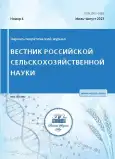Range and behavior of the Russian grain subcomplex center in 2000-2020
- Authors: Rakhaev K.M1, Bakkuev E.S1, Eneeva M.N1, Toguzaev T.K.1, Ivanova Z.M1
-
Affiliations:
- Kabardino-Balkar State Agrarian University named after V.M. Kokov
- Issue: No 4 (2023)
- Pages: 4-9
- Section: Articles
- URL: https://journals.rcsi.science/2500-2082/article/view/141499
- DOI: https://doi.org/10.31857/2500-2082/2023/4/4-9
- EDN: https://elibrary.ru/DLBREA
- ID: 141499
Cite item
Full Text
Abstract
About the authors
Kh. M Rakhaev
Kabardino-Balkar State Agrarian University named after V.M. Kokov
Email: r3bizengin@mail.ru
E. S Bakkuev
Kabardino-Balkar State Agrarian University named after V.M. Kokov
M. N Eneeva
Kabardino-Balkar State Agrarian University named after V.M. Kokov
T. Kh Toguzaev
Kabardino-Balkar State Agrarian University named after V.M. Kokov
Z. M Ivanova
Kabardino-Balkar State Agrarian University named after V.M. Kokov
References
- Алтухов А.И. Стратегия развития зернопродуктового подкомплекса - основа разработки схемы размещения и специализации зернового производства в стране // Вестник Курской государственной сельскохозяйственной академии. 2018. № 5. С. 146-152
- Долгосрочная стратегия развития зернового комплекса Российской Федерации до 2035 года: Распоряжение Правительства РФ от 10 августа 2019 г. № 1796-р. [Электронный ресурс]. URL: http://static.government.ru/media/files/y1IpA0ZfzdMCfATNBKGff1cXEQ142yAx.pdf (дата обращения 10. 12. 2022)
- Карпенко Г.Г., Антонцев А.А. Основные тенденции развития производства и рынка зерновых культур в России и мировом пространстве // Государственное управление. Электронный вестник. Выпуск № 69. Август 2018. Электронный ресурс: http://e-journal.spa.msu.ru/uploads/vestnik/2018/vipusk__69._avgust_2018_g./kommunikazionnii_menedjment_i_strategitcheskaja_kommunikazija_v_gosudarstvennom_upravlenii/karpenko_antontsev.pdf (Дата обращения 6.02.2023)
- Кушхова Б.А., Иванова З.М., Таусолтанов Х.М. Состояние и перспективы экспортного потенциала сельского хозяйства Северного Кавказа //Аграрный Вестник Урала. 2019. №11 (190). С. 80-91.
- Международный совет по зерну / [Электронный ресурс] URL: http://www.igc.int/ru (Дата обращения 6.02.2023).
- Менделеев Д.И. О центре России. В кн. "К познанию России". М.: Айрис-пресс. 2002. С.159-179.
- Рахаев Б.М., Энеева М.Н., Алибий Ф.М. Где находится экономический центр России и каким было его поведение в 2005-2015 гг.? //Известия РГО. 2019. Т.151. №5. С.67-78.
- Рахаев Х.М., Тогузаев Т.Х., Шахмурзова А.В. Некоторые методические аспекты определения экономического центра страны //Управленец. 2018. Т. 9. №3. С. 45-50.
- Регионы России. Социально-экономические показатели. Стат. сб. / Росстат. М., 2021. С. 433-434
- Святловский Е.Е. О центрографическом методе, как основном методе в экономической географии //Известия РГО. 1930. Т.62. Вып. 3. С.293-319; Электронный ресурс: https://yadi.sk/i/-JXsIe73e86gT (Дата обращения: 12.12.2022)
- Центрографический метод в экономической географии. Сб. науч. трудов. Отв. ред. Б.Лавров, Б.Родоман. Л.: Изд-во ГО СССР. 1989. 150 с.
- Gazaeva M., Bakkuev E., Gjatov A. Where is and where is shifting the economic center of Northern Caucasus //European Proceedings of Socialand Behavioural Sciences. 2019. №1.
- Nikitin A., Kuzichena N., Karsmnova N. Establishing efficient conditions for agriculture development // International journal of resent technology and engineering. 2019. Vol.8. № 2. PP. 1-6.
- Toguzaev Т., Rakhaev Kh., Modebadze N. The Second "Green Revolution": Fundamentals and Results of the New Integration and Cooperation in Agriculture // Cite as: AIP Conference Proceedings 2661, 020007 (2022); https://doi.org/10.1063/5.0109842 Published Online: 03 October 2022
- Xiao F.U., Yuan Shen, Rencai Dong et al. Analysis of Urbanization Based on Center-of-gravity Movement and Characteristics in Songhua River Basin of China and its Southern Source Sub-basin between 1990 and 2010 //Chinese Geographical Science. 2016. Vol. 26. No.1. Р. 117-128.
Supplementary files










